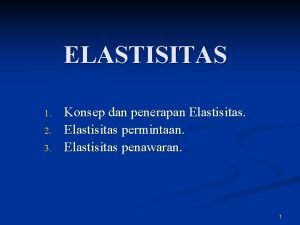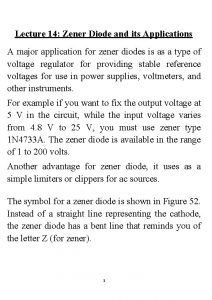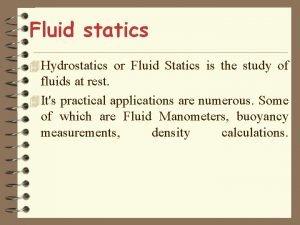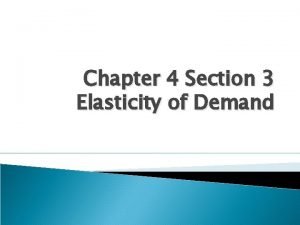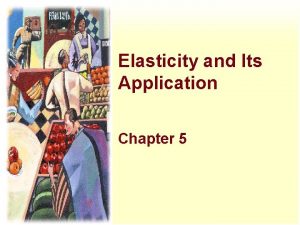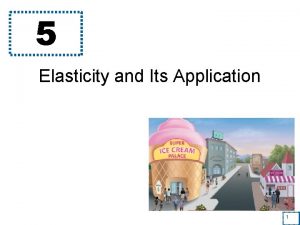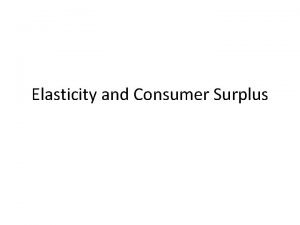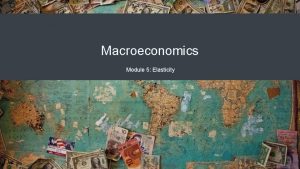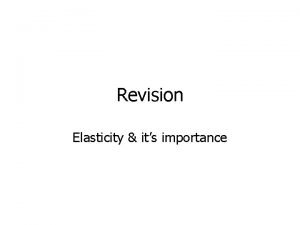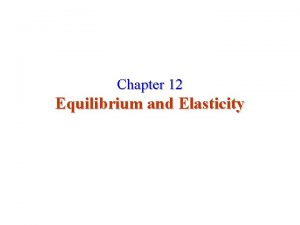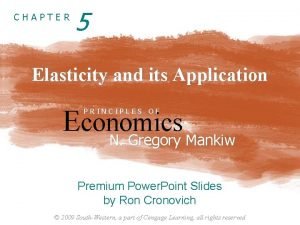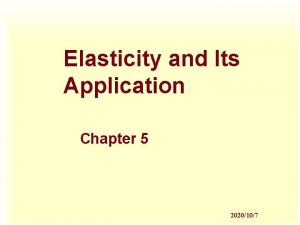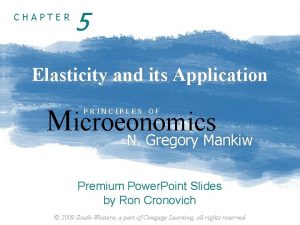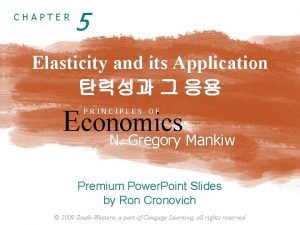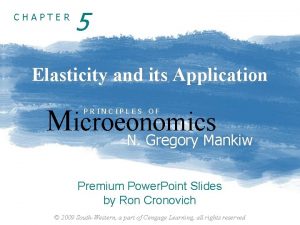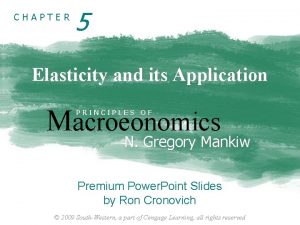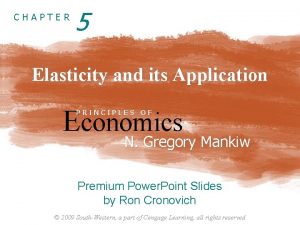Chapter 5 Elasticity and Its Application The Elasticity





































- Slides: 37

Chapter 5 Elasticity and Its Application

The Elasticity of Demand • Elasticity – Measure of the responsiveness of quantity demanded or quantity supplied – To one of its determinants 2

The Elasticity of Demand • Price elasticity of demand – Measure of how much quantity demanded of a good responds • To a change in the price of that good – Percentage change in quantity demanded • Divided by the percentage change in price – Measures how willing consumers are to buy less of the good as its price rises 3

The Elasticity of Demand • Price elasticity of demand – Elastic demand • Quantity demanded responds substantially to changes in the price – Inelastic demand • Quantity demanded responds only slightly to changes in the price 4

The Elasticity of Demand • Determinants of price elasticity of demand – Availability of close substitutes • Goods with close substitutes – More elastic demand – Necessities vs. luxuries • Necessities – inelastic demand • Luxuries – elastic demand – Definition of the market • Narrowly defined markets – more elastic demand – Time horizon – More elastic over longer time horizons 5

The Elasticity of Demand • Computing the price elasticity of demand – Percentage change in quantity demanded • Divided by percentage change in price – Use absolute value (drop the minus sign) • Midpoint method – Two points: (Q 1, P 1) and (Q 2, P 2) 6

The Elasticity of Demand • Variety of demand curves – Demand is elastic • Elasticity > 1 – Demand is inelastic • Elasticity < 1 – Demand has unit elasticity • Elasticity = 1 7

The Elasticity of Demand • Variety of demand curves – Demand is perfectly inelastic • Elasticity = 0 • Demand curve - vertical – Demand is perfectly elastic • Elasticity = infinity • Demand curve - horizontal – The flatter the demand curve • The greater the price elasticity of demand 8

Figure 1 The price elasticity of demand (a, b) (a) Perfectly inelastic demand: Elasticity = 0 Price (b) Inelastic demand: Elasticity < 1 Price Demand 1. An increase in price… $5 4 Demand 1. A 22% increase in price… $5 1. an 4 1. an 2. … leads to an 11% decrease in quantity demanded 2. …leaves the quantity demanded unchanged 0 100 Quantity 0 90 100 Quantity The price elasticity of demand determines whether the demand curve is steep or flat. Note that all percentage changes are calculated using the midpoint method. 9

Figure 1 The price elasticity of demand (c) Unit elastic demand: Elasticity = 1 Price Demand 1. A 22% increase in price… $5 4 1. an 2. … leads to A 22% decrease in quantity demanded 0 80 100 Quantity The price elasticity of demand determines whether the demand curve is steep or flat. Note that all percentage changes are calculated using the midpoint method. 10

Figure 1 The price elasticity of demand (d, e) (d) Elastic demand: Elasticity > 1 (e) Perfectly elastic demand: Elasticity equals infinity Price 1. A 22% increase in price… 1. At any price above $4, quantity demanded is zero $5 Demand 1. an 4 1. an $4 3. At any price below $4, quantity demanded is infinite 2. … leads to a 67% decrease in quantity demanded 0 50 100 Quantity 2. At exactly $4, consumers will buy any quantity 0 Demand Quantity The price elasticity of demand determines whether the demand curve is steep or flat. Note that all percentage changes are calculated using the midpoint method. 11

The Elasticity of Demand • Total revenue – Amount paid by buyers – Received by sellers of a good – Computed as: price of the good times the quantity sold (P ˣ Q) 12

Figure 2 Total revenue Price $4 1. an P ˣ Q=$400 (revenue) P 0 Demand 100 Quantity Q The total amount paid by buyers, and received as revenue by sellers, equals the area of the box under the demand curve, P × Q. Here, at a price of $4, the quantity demanded is 100, and total revenue is $400. 13

The Elasticity of Demand • Total revenue and price elasticity of demand • Inelastic demand – Increase in price • Increase in total revenue • Elastic demand – Increase in price • Decrease in total revenue 14

Figure 3 How total revenue changes when price changes (a) The Case of Inelastic Demand Price 1. an Revenue=$240 $1 Demand Revenue=$100 0 $3 100 Quantity Demand 0 80 Quantity The impact of a price change on total revenue (the product of price and quantity) depends on the elasticity of demand. In panel (a), the demand curve is inelastic. In this case, an increase in the price leads to a decrease in quantity demanded that is proportionately smaller, so total revenue increases. Here an increase in the price from $1 to $3 causes the quantity demanded to fall from 100 to 80. Total revenue rises from $100 to $240 15

Figure 3 How total revenue changes when price changes (b) The Case of Elastic Demand Price $5 $4 1. an Revenue =$200 Revenue=$100 Demand 0 50 Quantity Demand 0 20 Quantity The impact of a price change on total revenue (the product of price and quantity) depends on the elasticity of demand. In panel (b), the demand curve is elastic. In this case, an increase in the price leads to a decrease in quantity demanded that is proportionately larger, so total revenue decreases. Here an increase in the price from $4 to $5 causes the quantity 16 demanded to fall from 50 to 20. Total revenue falls from $200 to $100.

The Elasticity of Demand • When demand is inelastic – Price and total revenue move in the same direction • When demand is elastic – Price and total revenue move in opposite directions • If demand is unit elastic – Total revenue remains constant when the price changes 17

The Elasticity of Demand • Elasticity and total revenue along a linear demand curve • Linear demand curve – Constant slope – Different elasticities • Points with low price & high quantity – Inelastic • Points with high price & low quantity – Elastic 18

Figure 4 Elasticity of a linear demand curve (graph) Price Elasticity is larger than 1 $7 6 5 4 1. an 3 2 Demand 1 0 Elasticity is smaller than 1 2 4 6 8 10 12 14 Quantity The slope of a linear demand curve is constant, but its elasticity is not. The demand schedule in the table was used to calculate the price elasticity of demand by the midpoint method. At points with a low price and high quantity, the demand curve is inelastic. At points with a high price and low quantity, the demand curve is elastic. 19

Figure 4 Elasticity of a linear demand curve (schedule) Price Quantity Total revenue (Price ˣ Quantity) $7 6 5 4 3 2 1 0 O 2 4 6 8 10 12 14 $0 12 20 24 24 20 12 0 Percentage Change in Price Percentage Change in Quantity Elasticity Description 15 18 22 29 40 67 200 67 40 29 22 18 15 13. 0 3. 7 1. 8 1. 0 0. 6 0. 3 0. 1 Elastic Unit elastic Inelastic The slope of a linear demand curve is constant, but its elasticity is not. The demand schedule in the table was used to calculate the price elasticity of demand by the midpoint method. At points with a low price and high quantity, the demand curve is inelastic. At points with a high price and low quantity, the demand curve is elastic. 20

The Elasticity of Demand • Income elasticity of demand – Measure of how much the quantity demanded of a good responds • To a change in consumers’ income – Percentage change in quantity demanded • Divided by the percentage change in income – Normal goods: positive income elasticity • Necessities: smaller income elasticities • Luxuries: large income elasticities – Inferior goods: negative income elasticities 21

The Elasticity of Demand • Cross-price elasticity of demand – Measure of how much the quantity demanded of one good responds • To a change in the price of another good – Percentage change in quantity demanded of the first good • Divided by the percentage change in price of the second good – Substitutes: Positive cross-price elasticity – Complements: Negative cross-price elasticity 22

The Elasticity of Supply • Price elasticity of supply – Measure of how much the quantity supplied of a good responds • To a change in the price of that good – Percentage change in quantity supplied • Divided by the percentage change in price – Depends on the flexibility of sellers to change the amount of the good they produce 23

The Elasticity of Supply • Price elasticity of supply – Elastic supply • Quantity supplied responds substantially to changes in the price – Inelastic supply • Quantity supplied responds only slightly to changes in the price • Determinant of price elasticity of supply – Time period • Supply is more elastic in long run 24

The Elasticity of Supply • Computing price elasticity of supply – Percentage change in quantity supplied • Divided by percentage change in price • Variety of supply curves – Supply is perfectly inelastic • Elasticity =0 • Supply curve – vertical – Supply is perfectly elastic • Elasticity = infinity • Supply curve – horizontal 25

The Elasticity of Supply • Variety of supply curves – Unit elastic supply • Elasticity =1 – Elastic supply • Elasticity >1 – Inelastic supply • Elasticity < 1 26

Figure 5 The price elasticity of supply (a, b) (a) Perfectly inelastic supply: Elasticity = 0 Price (b) Inelastic supply: Elasticity < 1 Price Supply 1. An increase in price… $5 4 Supply 1. A 22% increase in price… $5 1. an 4 1. an 2. …leaves the quantity supplied unchanged 0 100 Quantity 0 100 110 2. … leads to a 10% increase in quantity supplied Quantity The price elasticity of supply determines whether the supply curve is steep or flat. Note that all percentage changes are calculated using the midpoint method. 27

Figure 5 The price elasticity of supply (c) Unit elastic supply: Elasticity =1 Price Supply 1. A 22% increase in price… $5 4 0 1. an 100 125 2. … leads to a 22% increase in quantity supplied Quantity The price elasticity of supply determines whether the supply curve is steep or flat. Note that all percentage changes are calculated using the midpoint method. 28

Figure 5 The price elasticity of supply (d, e) (d) Elastic supply: Elasticity > 1 (e) Perfectly elastic supply: Elasticity equals infinity Price 1. A 22% increase in price… 1. At any price above $4, quantity supplied is infinite Supply 2. At exactly $4, producers will supply any quantity $5 1. an 4 1. an $4 2. … leads to a 67% increase in quantity supplied 0 100 50 Quantity 3. At any price below $4, quantity supplied is zero 0 Supply Quantity The price elasticity of supply determines whether the supply curve is steep or flat. Note that all percentage changes are calculated using the midpoint method. 29

Figure 6 How the price elasticity of supply can vary Price Elasticity is small (less than 1). $15 Supply 12 Elasticity is large 1. an (greater than 1). 4 3 0 100 200 525 Quantity Because firms often have a maximum capacity for production, the elasticity of supply may be very high at low levels of quantity supplied and very low at high levels of quantity supplied. Here an increase in price from $3 to $4 increases the quantity supplied from 100 to 200. Because the 67 percent increase in quantity supplied (computed using the midpoint method) is larger than the 29 percent increase in price, the supply curve is elastic in this range. By contrast, when the price rises from $12 to $15, the quantity supplied rises only from 500 to 525. Because the 5 percent increase in quantity supplied is smaller than the 22 percent increase in 30 price, the supply curve is inelastic in this range.

Applications of Supply, Demand, & Elasticity • Can good news for farming be bad news for farmers? – New hybrid of wheat – increase production per acre 20% • Supply curve changes • Supply curve shifts to the right • Higher quantity; lower price • Demand – inelastic – Total revenue falls – Paradox of public policy • Induce farmers not to plant crops 31

Figure 7 An increase in supply in the market for wheat Price of Wheat 1. When demand is inelastic, an increase in supply. . . 2. … leads to a large fall in price. . . $3 S 1 S 2 3. … and a proportionately smaller increase in quantity sold. As a result, revenue falls from $300 to $220. 2 Demand 0 100 110 Quantity of Wheat When an advance in farm technology increases the supply of wheat from S 1 to S 2, the price of wheat falls. Because the demand for wheat is inelastic, the increase in the quantity sold from 100 to 110 is proportionately smaller than the decrease in the price from $3 to $2. As a result, farmers’ total revenue falls from $300 ($3 × 100) to $220 32 ($2 × 110).

Applications of Supply, Demand, & Elasticity • Why did OPEC fail to keep the price of oil high? – 1970 s: OPEC reduced supply of oil • Increase in prices 1973 -1974 and 1971 -1981 • Short-run: supply is inelastic – Decrease in supply: large increase in price – 1982 -1990 – price of oil decreased • Long-run: supply is elastic – Decrease in supply: small increase in price 33

Figure 8 A reduction in supply in the world market for oil (a) The Oil Market in the Short Run Price 1. In the short run, when supply and demand are inelastic, a shift in supply. . . S 2 (b) The Oil Market in the Long Run Price 1. In the long run, when supply and demand are elastic, a shift in supply. . . S 1 S 2 P 1 1. an 2. … leads to a large increase in price 1. an P 2 P 1 2. … leads to a small increase in price Demand 0 Quantity S 1 0 Demand Quantity When the supply of oil falls, the response depends on the time horizon. In the short run, supply and demand are relatively inelastic, as in panel (a). Thus, when the supply curve shifts from S 1 to S 2, the price rises substantially. By contrast, in the long run, supply and demand are relatively elastic, as in panel (b). In this case, the same size shift in the supply curve (S 1 to S 2) causes a smaller increase in the price. 34

Applications of Supply, Demand, & Elasticity • Does drug interdiction increase or decrease drug-related crime? – Government increases the number of federal agents devoted to the war on drugs • Illegal drugs - Supply curve shifts left – Higher price; lower quantity – Amount of drug-related crimes • Inelastic demand for drugs • Higher drugs price – higher total revenue • Increase drug-related crime 35

Applications of Supply, Demand, & Elasticity • Does drug interdiction increase or decrease drug-related crime? – Policy of drug education • Reduce demand for illegal drugs • Left shift of demand curve • Lower quantity; lower price • Reduce drug-related crime 36

Figure 9 Policies to reduce the use of illegal drugs (a) Drug Interdiction (b) Drug Education 1. Drug interdiction reduces the supply of drugs. . . Price 2. … which raises the price. . . S 2 Price S 1 1. Drug education reduces the demand for drugs. . . 2. . which reduces the price. . . Supply P 2 1. an P 1 3. … and reduces the quantity sold P 1 P 2 3. … and reduces the quantity sold Demand 0 Q 2 Q 1 Quantity 1. an 0 D 2 D 1 Q 2 Q 1 Quantity Drug interdiction reduces the supply of drugs from S 1 to S 2, as in panel (a). If the demand for drugs is inelastic, then the total amount paid by drug users rises, even as the amount of drug use falls. By contrast, drug education reduces the demand for drugs from D 1 to D 2, as 37 in panel (b). Because both price and quantity fall, the amount paid by drug users falls
 Chapter 5 elasticity and its application multiple choice
Chapter 5 elasticity and its application multiple choice Elastisitas dan penerapannya
Elastisitas dan penerapannya Elasticity and its application in economics
Elasticity and its application in economics Application of elasticity
Application of elasticity Wheelchair physics
Wheelchair physics Static equilibrum
Static equilibrum Zener diode and its application
Zener diode and its application Law of hydrostatics
Law of hydrostatics The emigree poem analysis
The emigree poem analysis Its halloween its halloween the moon is full and bright
Its halloween its halloween the moon is full and bright Section 3 elasticity of demand
Section 3 elasticity of demand Chapter 4 lesson 3 elasticity of demand answer key
Chapter 4 lesson 3 elasticity of demand answer key Chapter 4 section 3 elasticity of demand
Chapter 4 section 3 elasticity of demand When a train increases its velocity, its momentum
When a train increases its velocity, its momentum Sunny cloudy windy rainy
Sunny cloudy windy rainy If its square its a sonnet summary
If its square its a sonnet summary Its not easy but its worth it
Its not easy but its worth it Hát kết hợp bộ gõ cơ thể
Hát kết hợp bộ gõ cơ thể Ng-html
Ng-html Bổ thể
Bổ thể Tỉ lệ cơ thể trẻ em
Tỉ lệ cơ thể trẻ em Voi kéo gỗ như thế nào
Voi kéo gỗ như thế nào Thang điểm glasgow
Thang điểm glasgow Alleluia hat len nguoi oi
Alleluia hat len nguoi oi Các môn thể thao bắt đầu bằng tiếng đua
Các môn thể thao bắt đầu bằng tiếng đua Thế nào là hệ số cao nhất
Thế nào là hệ số cao nhất Các châu lục và đại dương trên thế giới
Các châu lục và đại dương trên thế giới Công thức tính độ biến thiên đông lượng
Công thức tính độ biến thiên đông lượng Trời xanh đây là của chúng ta thể thơ
Trời xanh đây là của chúng ta thể thơ Mật thư tọa độ 5x5
Mật thư tọa độ 5x5 101012 bằng
101012 bằng độ dài liên kết
độ dài liên kết Các châu lục và đại dương trên thế giới
Các châu lục và đại dương trên thế giới Thể thơ truyền thống
Thể thơ truyền thống Quá trình desamine hóa có thể tạo ra
Quá trình desamine hóa có thể tạo ra Một số thể thơ truyền thống
Một số thể thơ truyền thống Cái miệng bé xinh thế chỉ nói điều hay thôi
Cái miệng bé xinh thế chỉ nói điều hay thôi Vẽ hình chiếu vuông góc của vật thể sau
Vẽ hình chiếu vuông góc của vật thể sau

